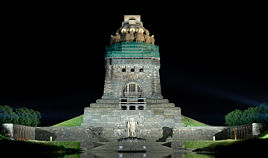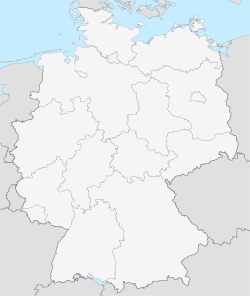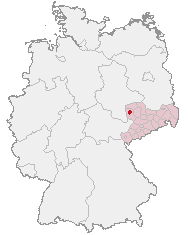Leipzig
|
||||||||||||||||||||||||||||||||||||||||||||

A map from Meyers Encyclopedia depicting the Battle of Leipzig on 18 October 1813.
|
||||||||||||||||||||||||||||||||||||||||||||
|
Leipzig Old City
|
||||||||||||||||||||||||||||||||||||||||||||

Atrium of the "Academy of Visual Arts".
|
||||||||||||||||||||||||||||||||||||||||||||
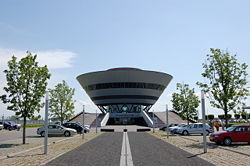
"Porsche Diamond" The customer centre building of Porsche Leipzig.
|
||||||||||||||||||||||||||||||||||||||||||||

MDR, one of Germany's public broadcasters.
|
||||||||||||||||||||||||||||||||||||||||||||

City-Hochhaus Leipzig.
|
||||||||||||||||||||||||||||||||||||||||||||

Mädler-Passage, one of Leipzig's many passageways.
|
||||||||||||||||||||||||||||||||||||||||||||

New Trade Fair.
|
||||||||||||||||||||||||||||||||||||||||||||

Palais Roßbach, one of the many Gründerzeit-buildings in Leipzig
|
||||||||||||||||||||||||||||||||||||||||||||

Inside Leipzig Hbf (Central Railway Station).
|
||||||||||||||||||||||||||||||||||||||||||||

The Federal Administrative Court of Germany at night
Leipzig Neues Rathaus
|
||||||||||||||||||||||||||||||||||||||||||||
Leipzig ([ˈlaɪ̯pt͡sɪç], Upper Sorbian: Lipsk) is, with a population of over 511,252[1], the largest city in the federal state of Saxony, Germany.
Contents |
History
see also Category:People from Leipzig
Origins
Leipzig's name is derived from the Slavic word Lipsk, which means "settlement where the linden trees (US; lime trees in UK) stand".[2]
First documented in 1015 and endowed with city and market privileges in 1165, Leipzig has fundamentally shaped the history of Saxony and of Germany. Leipzig has always been known as a place of commerce. The Leipzig Trade Fair, which began in the Middle Ages, is the oldest remaining trade fair in the world. It became an event of international importance.
The foundation of the University of Leipzig in 1409 initiated the city's development into a centre of German law and the publishing industry, and towards being a location of the Reichsgericht (High Court), and the German National Library (founded in 1912). The philosopher and mathematician Gottfried Wilhelm Leibniz was born in Leipzig in 1646, and attended the University of Leipzig from 1661–1666.
The importance of the Trade Fair and the University in the creation of a vibrant urban life and city politics from the Reformation through the 19th century cannot be overestimated.
The nineteenth century
The Leipzig region was the arena of the Battle of the Nations, which ended Napoleon's run of conquest in Europe, and led to his first exile on Elba. In 1913 the Völkerschlachtdenkmal monument celebrating the centenary of this event was completed.
A terminal of the first German long distance railway to Dresden (the capital of Saxony), in 1839, Leipzig became a hub of Central European railway traffic, with the renowned Leipzig Central station, the largest terminal station by area in Europe.

Leipzig expanded rapidly towards one million inhabitants. Huge Gründerzeit areas were built, which mostly survived the war and post-war demolition.
Leipzig became a centre of the German and Saxon liberal movements. The first German labour party, the General German Workers' Association (Allgemeiner Deutscher Arbeiterverein, ADAV) was founded in Leipzig on 23 May 1863 by Ferdinand Lassalle; about 600 workers from across Germany travelled to the foundation on the new railway line.
The twentieth century
The city's mayor from 1930 to 1937, Carl Friedrich Goerdeler was a noted opponent of the Nazi regime in Germany. He resigned in 1937 when, in his absence, his Nazi deputy ordered the destruction of the city's statue of Felix Mendelssohn. On Kristallnacht in 1938, one of the city's most architecturally significant buildings, the 1855 Moorish Revival Leipzig synagogue was deliberately destroyed.
The city was also heavily damaged by Allied bombing during World War II. American troops of the 69th Infantry Division captured the city on 20 April 1945, Adolf Hitler's 56th and last birthday. The U.S. turned over the city to the Red Army as it pulled back from the line of contact with Soviet forces in July 1945 to the pre-designated occupation zone boundaries. Leipzig became one of the major cities of the German Democratic Republic.
In the mid-twentieth century, the city's Trade Fair assumed renewed importance as a point of contact with the Comecon Eastern Europe economic bloc, of which East Germany was a member.
In October 1989, after prayers for peace at St. Nicholas' Church, established in 1983 as part of the peace movement, the Monday demonstrations started as the most prominent mass protest against the East German regime. [3]
Leipzig was the German candidate for the 2012 Summer Olympics, but did not make it to the short list.
Music in Leipzig
see also Category:Music from Leipzig
Johann Sebastian Bach worked in Leipzig from 1723 to 1750, at the St. Thomas Lutheran church, and Richard Wagner the composer was born in Leipzig in 1813, in the Brühl. Robert Schumann was also active in Leipzig music, having been invited by Felix Mendelssohn when the latter established Germany's first musical conservatoire in the city in 1843.
This conservatoire is today the University of Music and Theatre. A broad range of subjects can be studied, both artistic and teacher training, in all orchestral instruments, voice, interpretation, coaching, piano chamber music, orchestral conducting, choir conducting and musical composition. Musical styles include jazz, popular music, musicals, early music and church music. The drama departments teach acting and dramaturgy. Advanced students may, after a test, stand in for members of the Gewandhaus Orchestra. As at 2006, approximately 900 students were enrolled at the school.
The city's musical tradition is also reflected in the worldwide fame of the Leipzig Gewandhaus Orchestra and the choir of the St. Thomas Church.
Main sights
- St Thomas' Church (Thomaskirche): Most famous as the place where Johann Sebastian Bach worked as a cantor and home to the renowned Thomaner choir
- Völkerschlachtdenkmal (Battle of the Nations Monument): the largest war monument in Europe, built to commemorate the victorious battle against Napoleonic troops
- Gewandhaus: home to the famous Gewandhaus Orchestra, it is the third building of that name
- Altes Rathaus: the old city hall was built in 1556 and houses a museum of the city's history
- Neues Rathaus: the new city hall was built upon the remains of the Pleißenburg, a castle that was the site of the 1519 debate between Johann Eck and Martin Luther in 1519
- City-Hochhaus Leipzig: built in 1972, it was once part of the university and is the city's tallest building
- Auerbach's Keller: a young Goethe ate and drank here while studying in Leipzig; it is the venue of a scene from his Faust
- Städtisches Kaufhaus (municipal department store): the world's first sample fair building and today home to offices, retail stores, restaurants and interim classrooms for the University of Leipzig (its name is misleading, as it is privately owned)
- Bundesverwaltungsgericht: Germany's federal administrative court was the site of the Reichsgericht, the highest state court between 1888 and 1945
Among Leipzig's noteworthy institutions are the opera house and the Leipzig Zoo, the latter of which houses the world's largest facilities for primates. The Church of St. Nicholas (Nikolaikirche) was the starting point of peaceful Monday demonstrations for the reunification of Germany. Leipzig's international trade fair in the north of the city is home to the world's largest levitated glass hall. Leipzig is also known for its passageways through houses and buildings.
Education
Leipzig University, founded 1409, is one of Europe's oldest universities. Nobel Prize laureate Werner Heisenberg worked here as a physics professor (from 1927 to 1942), as did Nobel Prize laureates Gustav Ludwig Hertz (physics), Wilhelm Ostwald (chemistry) and Theodor Mommsen (Nobel Prize in literature). Other former staff of faculty include mineralogist Georg Agricola, writer Gotthold Ephraim Lessing, philosopher Ernst Bloch, eccentric founder of psychophysics Gustav Theodor Fechner, and psychologist Wilhelm Wundt. Among the university's many noteworthy students were writers Johann Wolfgang Goethe and Erich Kästner, philosophers Gottfried Leibniz and Friedrich Nietzsche, political activist Karl Liebknecht, and composer Richard Wagner. Germany's chancellor since 2006, Angela Merkel, studied physics at Leipzig University. The university has about 30,000 students.
The "Academy of Visual Arts" (Hochschule für Grafik und Buchkunst) was established 1764. Its 530 students (as of 2006) are enrolled in courses in painting and graphics, book design/graphic design, photography and media art. The school also houses an Institute for Theory.
The "Leipzig University of Applied Sciences" (Hochschule für Technik, Wirtschaft und Kultur, HTWK) is with about 6200 students (as of 2007) the second biggest institution of higher education in Leipzig. It was founded in 1992, merging several older schools. As a university of applied sciences (German: Fachhochschule) it is slightly below the status of a university, with more emphasis on the practical part of the education. The HTWK offers many engineering courses, as well as courses of computer sciences, mathematics, business administration, library sciences, museum studies, and social work. It is mainly located in the south of the city.
The private Handelshochschule Leipzig (HHL), or Leipzig Graduate School of Management, is the oldest business school in Germany.
Among the research institutes located in Leipzig three belong to the Max Planck Society (for Mathematics in the Sciences, Human Cognitive and Brain Science and Evolutionary Anthropology) and two are Fraunhofer Society institutes. Others are the Helmholtz Centre for Environmental Research UFZ, part of the Helmholtz Association, and the Leibniz-Institute for Tropospheric Research.
Economy
Companies in or around Leipzig include:
Many bars, restaurants and stores found in the "centre city" region rely on German and foreign tourists. The railway station itself is the location of one of the largest shopping centres.
Some of the largest employers in the area (outside of manufacturing) include the various schools and universities in and around the Leipzig/Halle region. The University of Leipzig attracts millions of Euros of investment yearly and is in the middle of a massive construction and refurbishment in order to celebrate their 600th anniversary.
DHL is in the process of transferring the bulk of its European air operations from Brussels Airport to Leipzig/Halle Airport. The airport is also a major source of income for the area and offers many flights daily through Lufthansa, Germany's main carrier.
Media
- MDR, one of Germany's public broadcasters, has its headquarters and main television studios in the city. It provides programs to various TV and radio networks and has its own symphony orchestra, choir and a ballet.
- Leipziger Volkszeitung (LVZ) is the city's only daily newspaper. Founded in 1894, it has published under several different forms of government. It was the first newspaper in the world that was published daily. The monthly magazine Kreuzer specializes on culture, festivities and the arts in Leipzig.
- Once known for its large number of publishing houses, Leipzig had been called "Buch-Stadt" (book city). Few are left after the years of the German Democratic Republic, the most notable of them being branches of Brockhaus and Insel Verlag. Reclam, founded in 1828, was one of the large publishing houses to move away. The German Library (Deutsche Bücherei) in Leipzig is part of Germany's National Library.
- On 26 November 1990, the Norwegian Black metal band Mayhem recorded their oft-regarded as seminal live album Live in Leipzig.
Annual events
- Auto Mobil International (AMI) motor show [4] .
- AMITEC, the most important trade fair for vehicle maintenance, care, servicing and repairs in Germany and Central Europe [5].
- A capella: vocal music festival
- Bachfest: Johann Sebastian Bach-festival
- Christmas market (since 1767)
- Dokfestival: international festival for documented and animated film
- GC - Games Convention: video game & developers convention
- Jazztage: contemporary jazz festival
- Ladyfest Leipzig:(August) Emancipatoric, feminist Punk & Electro Festival
- Leipzig Book Fair: the second largest German book fair
- Stadtfest: city festival
- Wave-Gotik-Treffen at Pentecost: world's largest goth or "dark culture" festival
Sport
The German Football Association (DFB) was founded in Leipzig in 1900.
The city was the venue for the 2006 FIFA World Cup draw, and hosted four first-round matches and one match in the last 16th round in the football club FC Sachsen Leipzig's home stadium Zentralstadion.
Leipzig also hosted the Fencing World Cup in 2005 and hosts a number of international competitions in a variety of sports each year.
VfB Leipzig, now 1. FC Lokomotive Leipzig, won the first national football championship in 1903.
Two-time World Cup Uneven Bars Champion and Olympic Medalist (1976, 1980) in gymnastics, Steffi Kraker was born in Leipzig.
Transportation
Leipzig Central station is at a junction of important north-to-south and west-to-east railway lines. An underground connecting line has been driven along the north-south axis. In the vicinity of the city are two airports: Leipzig/Halle Airport and Leipzig-Altenburg Airport (Thuringia).
Quotations
Mein Leipzig lob' ich mir! Es ist ein klein Paris und bildet seine Leute. (I praise my Leipzig! It is a small Paris and educates its people.) - Frosch, a university student in Goethe's Faust, Part One
Twin cities
Leipzig is twinned with:
 Addis Ababa, Ethiopia since 2004
Addis Ababa, Ethiopia since 2004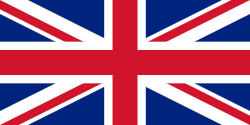 Birmingham, United Kingdom ([1]) since 1992
Birmingham, United Kingdom ([1]) since 1992 Bologna, Italy since 1962, renewed in 1997
Bologna, Italy since 1962, renewed in 1997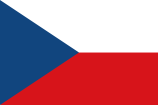 Brno, Czech Republic since 1973, renewed in 1999
Brno, Czech Republic since 1973, renewed in 1999 Frankfurt am Main, Germany since 1990
Frankfurt am Main, Germany since 1990 Hanover, Germany since 1987
Hanover, Germany since 1987 Houston, United States since 1993
Houston, United States since 1993 Kiev, Ukraine since 1961, renewed in 1992
Kiev, Ukraine since 1961, renewed in 1992 Kraków, Poland since 1973, renewed in 1995
Kraków, Poland since 1973, renewed in 1995 Lyon, France since 1981
Lyon, France since 1981 Nanjing, China since 1988
Nanjing, China since 1988 Thessaloniki, Greece since 1984
Thessaloniki, Greece since 1984 Travnik, Bosnia and Herzegovina since 2003
Travnik, Bosnia and Herzegovina since 2003 Plovdiv, Bulgaria since 1975, renewed in 2007
Plovdiv, Bulgaria since 1975, renewed in 2007
See also
- List of mayors of Leipzig.
- Leipzig Human Rights Award.
- Auto Mobil International motor show in Leipzig.
References
- ↑ www.statistik.sachsen.de
- ↑ Hanswilhelm Haefs. Das 2. Handbuch des nutzlosen Wissens. ISBN 3831137544 (German)
- ↑ David Brebis (ed.), Michelin guide to Germany, Greenville (2006), p. 324. ISBN 086699077417
- ↑ AMI - Auto Mobil International, Leipziger Messe
- ↑ AMITEC - Fachmesse für Fahrzeugteile, Werkstatt und Service, Leipziger Messe
External links
- Leipzig travel guide from Wikitravel
- The city's official website
- Leipzig links in the Open Directory Project (DMOZ)
